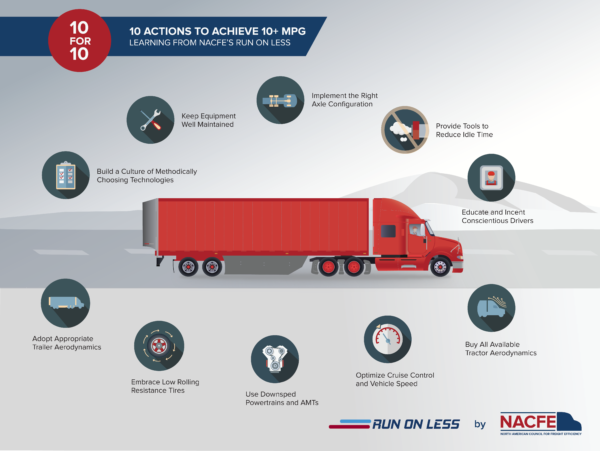Expect more Run on Less from NACFE

ATLANTA, Ga. – The North American Council for Freight Efficiency has unveiled a new look and redesigned website (www.nacfe.org) as it widens its focus beyond the fuel-saving equipment and components on the road today.
The organization’s original goal was to promote the doubling of freight-moving efficiency. And the recent Run on Less event proved that target is “pretty practical”, said executive director Mike Roeth, during a briefing at the Technology and Maintenance Council’s annual meeting.
Seven trucks participating in Run on Less proved an average of 10.1 mpg (23.3 L/100 km) is possible with existing technologies, and under real-world operating conditions. This compares to a national average of 6.4 mpg (36.75 L/100 km), and U.S. Department of Energy super trucks achieving 11-13 mpg (21.38-18.09 L/100km).
The demonstration run, which concluded during the recent North American Commercial Vehicle Show, identified 10 actions to reach 10 mpg, including:
- Keep equipment well-maintained
- Build a culture of methodically choosing technologies
- Adopt appropriate trailer aerodynamics
- Embrace low-rolling-resistance tires
- Use downsped powertrains and automated manual transmissions
- Implement the right axle configuration
- Provide tools to reduce idle time
- Educate and incent conscientious drives
- Buy all available tractor aerodynamics
- Optimize cruise control and vehicle speed
Calculations based on International Fuel Tax Agreement data surrounding traveled miles and burned fuel suggest average fuel economy is closer to 5.9 mpg (39.87 L/100 km), but that includes vocational and agricultural vehicles, he stressed. It also involves an array of model years.
“Ten miles per gallon does happen in the real world. It does happen hauling goods. It’s not all about running empty downhill,” Roeth said, admitting that the demonstrated fuel economy was higher than expected.
Participating trucks averaged 87 km/h over 17 days, collectively covering 80,600 km, and averaging gross weights of 55,000 pounds.
A second Run on Less is now in the works, and proposals for that have included Canadian or Mexican runs, owner-operators running older equipment, and day cabs. New data sets could even look at factors such as traffic.
Meanwhile, the council has unveiled plans for new Guidance Reports, the first of which will explore the potential of electric vehicles and be released this spring.
“What we’ve decided to do is guide future change,” Roeth said, referring to how these will differ from the council’s 16 Confidence Reports that have explored about 70 existing technologies. Those reflect confidence in technologies compared to the anticipated paybacks.
“We are now looking at future products that are coming down the road,” he said. “The future becomes the emerging, becomes the now.”
Have your say
This is a moderated forum. Comments will no longer be published unless they are accompanied by a first and last name and a verifiable email address. (Today's Trucking will not publish or share the email address.) Profane language and content deemed to be libelous, racist, or threatening in nature will not be published under any circumstances.